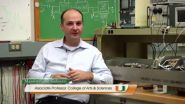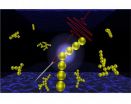(Press-News.org) CAMBRIDGE, MA -- The magnets cluttering the face of your refrigerator may one day be used as cooling agents, according to a new theory formulated by MIT researchers.
The theory describes the motion of magnons — quasi-particles in magnets that are collective rotations of magnetic moments, or "spins." In addition to the magnetic moments, magnons also conduct heat; from their equations, the MIT researchers found that when exposed to a magnetic field gradient, magnons may be driven to move from one end of a magnet to another, carrying heat with them and producing a cooling effect.
"You can pump heat from one side to the other, so you can essentially use a magnet as a refrigerator," says Bolin Liao, a graduate student in MIT's Department of Mechanical Engineering. "You can envision wireless cooling where you apply a magnetic field to a magnet one or two meters away to, say, cool your laptop."
In theory, Liao says, such a magnetically driven refrigerator would require no moving parts, unlike conventional iceboxes that pump fluid through a set of pipes to keep things cool.
Liao, along with graduate student Jiawei Zhou and Department of Mechanical Engineering head Gang Chen, have published a paper detailing the magnon cooling theory in Physical Review Letters.
"People now have a new theoretical playground to study how magnons move under coexisting field and temperature gradients," Liao says. "These equations are pretty fundamental for magnon transport."
A cool effect
In a ferromagnet, the local magnetic moments can rotate and align in various directions. At a temperature of absolute zero, the local magnetic moments align to produce the strongest possible magnetic force in a magnet. As temperature increases, a magnet becomes weaker as more local magnetic moments spin away from the shared alignment; a magnon population is created with this elevated temperature.
In many ways, magnons are similar to electrons, which can simultaneously carry electrical charge and conduct heat. Electrons move in response to either an electric field or a temperature gradient — a phenomenon known as the thermoelectric effect. In recent years, scientists have investigated this effect for applications such as thermoelectric generators, which can be used to convert heat directly into electricity, or to deliver cooling without any moving parts.
Liao and his colleagues recognized a similar "coupled" phenomenon in magnons, which move in response to two forces: a temperature gradient or a magnetic field. Because magnons behave much like electrons in this aspect, the researchers developed a theory of magnon transport based on a widely established equation for electron transport in thermoelectrics, called the Boltzmann transport equation.
From their derivations, Liao, Zhou, and Chen came up with two new equations to describe magnon transport. With these equations, they predicted a new magnon cooling effect, similar to the thermoelectric cooling effect, in which magnons, when exposed to a magnetic field gradient, may carry heat from one end of a magnet to the other.
Motivating new experiments
Liao used the properties of a common magnetic insulator to model how this magnon cooling effect may work in existing magnetic materials. He collected data for this material from previous literature, and plugged the numbers into the group's new model. He found that while the effect was small, the material was able to generate a cooling effect in response to a moderate magnetic field gradient. The effect was more pronounced at cryogenic temperatures.
The theoretical results suggest to Chen that a first application for magnon cooling may be for scientists working on projects that require wireless cooling at extremely low temperatures.
"At this stage, potential applications are in cryogenics — for example, cooling infrared detectors," Chen says. "However, we need to confirm the effect experimentally and look for better materials. We hope this will motivate new experiments."
Liao points out that magnons also add to the arsenal of tools for improving existing thermoelectric generators — which, while potentially innovative in their ability to generate electricity from heat, are also relatively inefficient.
"There's still a long way to go for thermoelectrics to compete with traditional technologies," Liao says. "Studying the magnetic degree of freedom could potentially help optimize existing systems and improve the thermoelectric efficiency."
INFORMATION:
The work was partly supported by the U.S. Department of Energy and the Air Force Office of Scientific Research.
Written by Jennifer Chu, MIT News Office
Refrigerator magnets
2014-07-28
ELSE PRESS RELEASES FROM THIS DATE:
Children with disabilities benefit from classroom inclusion
2014-07-28
COLUMBUS, Ohio – The secret to boosting the language skills of preschoolers with disabilities may be to put them in classrooms with typically developing peers, a new study finds.
Researchers found that the average language skills of a child's classmates in the fall significantly predicted the child's language skills in the spring – especially for children with disabilities.
The results support inclusion policies in schools that aim to have students with disabilities in the same classrooms alongside their typically developing peers, said Laura Justice, co-author of the ...
Study shows new link between obesity in the young and the lowering of age of puberty
2014-07-28
A new link has been identified between obesity in childhood and the lowering of the age of puberty.
The research which discovered the link, carried out at Plymouth University Peninsula Schools of Medicine and Dentistry, is published in the Journal of Clinical Endocrinology and Metabolism.
The study focuses on a protein called sex hormone-binding globulin (SHBG), the regulation and role of which in children are poorly defined. SHBG binds to the sex hormones androgen and oestrogen. SHGB levels are initially high in childhood but decline significantly before puberty, in ...
Henry Ford study: Burnout impacts transplant surgeons
2014-07-28
VIDEO:
Despite saving thousands of lives yearly, nearly half of organ transplant surgeons report a low sense of personal accomplishment and 40 percent feel emotionally exhausted, according to a new national...
Click here for more information.
DETROIT – Despite saving thousands of lives yearly, nearly half of organ transplant surgeons report a low sense of personal accomplishment and 40% feel emotionally exhausted, according to a new national study on transplant surgeon burnout.
The ...
Many people never grow out of their growing pains
2014-07-28
Over the years, many adolescents have been forced to accept the diagnosis "growing pains" when they complained about pain in their knees. A new PhD study involving 3,000 adolescents has now shown that the knee pain often carries on:
"We can see from the study that one in three young people between the ages of 12 and 19 experience problems with pain in their knees. Seven percent of the adolescents experience daily knee pain in the front of the knee," says physiotherapist and PhD Michael Skovdal Rathleff from Aarhus University, and continues:
"More than half still have ...
Glow in space is evidence of a hot bubble in our galaxy
2014-07-28
VIDEO:
Dr. Massimilano Galeazzi discusses his work on a sounding rocket, sent into the atmosphere to search for answers about the universe.
Click here for more information.
CORAL GABLES, Fla. (July 27, 2014) — When we look up to the heavens on a clear night, we see an immense dark sky with uncountable stars. With a small telescope we can also see galaxies, nebulae, and the disks of planets. If you look at the sky with an X-ray detector, you would see many of these same familiar ...
Interfering with interferon
2014-07-28
Using the body's natural virus killers to prevent and treat HIV infection has been problematic until now because of the strong inflammatory response these molecules can arouse as they get rid of the invaders. Now, collaborative research conducted by scientists at the Weizmann Institute and the National Institutes of Health (NIH) have demonstrated how suppressing the activity of these molecules – interferons – around the time of infection could have long-term implications for the course of the disease. Their research appeared in Nature.
Interferons, named for their ability ...
Industrial lead pollution beat explorers to the South Pole by 22 years and persists today
2014-07-28
RENO – Norwegian explorer Roald Amundsen became the first man to reach the South Pole in December of 1911. More than 100 years later, an international team of scientists led by Joe McConnell of Nevada's Desert Research Institute (DRI) have proven that air pollution from industrial activities arrived long before.
Using data from 16 ice cores collected from widely spaced locations around the Antarctic continent, including the South Pole, McConnell's team created the most accurate and precise reconstruction to date of lead pollution over the Earth's southernmost continent. ...
Building 'invisible' materials with light
2014-07-28
A new method of building materials using light, developed by researchers at the University of Cambridge, could one day enable technologies that are often considered the realm of science fiction, such as invisibility cloaks and cloaking devices.
Although cloaked starships won't be a reality for quite some time, the technique which researchers have developed for constructing materials with building blocks a few billionths of a metre across can be used to control the way that light flies through them, and works on large chunks all at once. Details are published today (28 ...
Superconductivity could form at high temperatures in layered 2D crystals
2014-07-28
An elusive state of matter called superconductivity could be realized in stacks of sheetlike crystals just a few atoms thick, a trio of physicists has determined.
Superconductivity, the flow of electrical current without resistance, is usually found in materials chilled to the most frigid temperatures, which is impractical for most applications. It's been observed at higher temperatures–higher being about 100 kelvin or minus 280 degrees below zero Fahrenheit–in copper oxide materials called cuprate superconductors. But those materials are brittle and unsuitable for fabricating ...
Lifestyle choices may affect the long-term heart health of childhood cancer survivors
2014-07-28
A new study has found that following a healthy lifestyle may lower childhood cancer survivors' risk of developing the metabolic syndrome. Published early online in CANCER, a peer-reviewed journal of the American Cancer Society, the findings indicate that children with cancer and adults who had cancer when they were children should receive information about how their lifestyle may influence their long-term health.
Adults who had cancer as children are known to be at increased risk for the metabolic syndrome, a group of risk factors that increases the likelihood of developing ...




